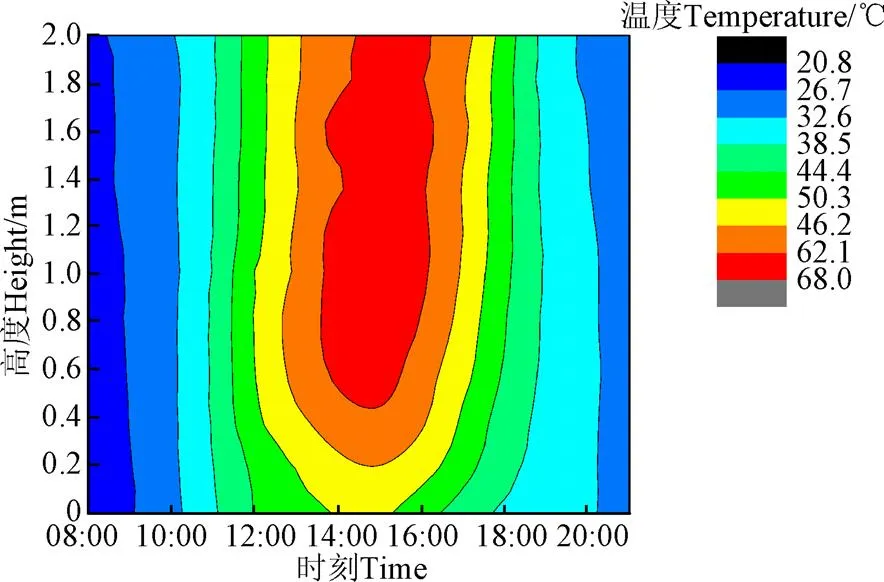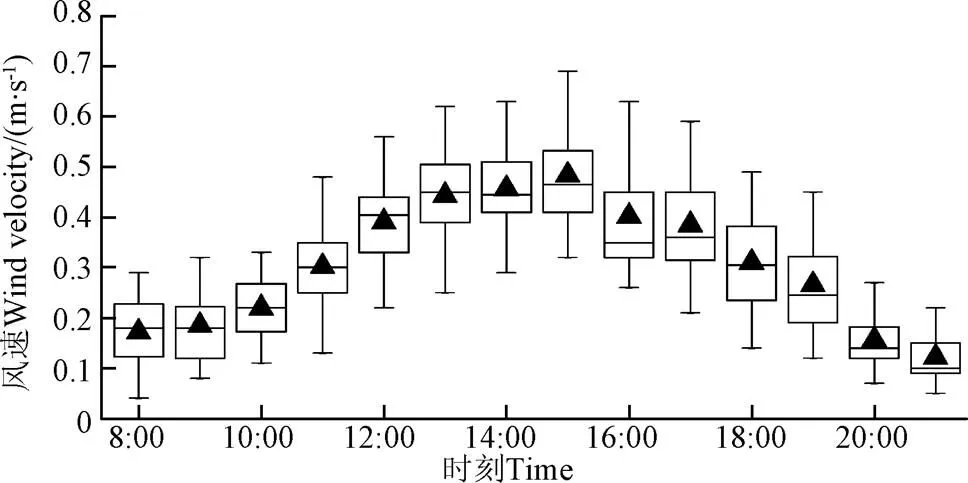新疆农村被动式太阳房夏季不同降温控制模式的降温效果
徐 鑫,李 洁,姜曙光,代 金,吴梦云
新疆农村被动式太阳房夏季不同降温控制模式的降温效果
徐 鑫,李 洁※,姜曙光,代 金,吴梦云
(石河子大学水利建筑工程学院,石河子 832000)
冬季供暖性能良好的被动式太阳房,夏季室内普遍存在着过热问题。该文以新疆石河子农村的2栋不同构造的被动式太阳房为研究对象,提出4种不同的降温控制模式。通过夏季降温试验研究,重点讨论了白天热压通风、夜间自然通风、地板辐射供冷等措施对于缓解被动式太阳房夏季过热程度的作用,并在此基础上分析了降温措施对室内热舒适适应性的影响程度。试验结果表明:对于新疆农村没有地下室的被动式太阳房,采用该文提出的热压通风结合夜间通风降温模式,满足80%可接受舒适度要求的时长占比可提升35.04%;耦合地下室的被动式太阳房,依靠合理的通风措施和地板辐射供冷,满足80%可接受舒适度的时长占比达到85.80%,可基本实现夏季降温的目标。
农村;降温;太阳房;热压通风;地面辐射供冷
0 引 言
研究表明,冬季供暖性能良好的被动式太阳房,由于集热墙外表面温度较高,夏季室内普遍存在着过热现象[1]。为了解决这个问题,国内外学者对被动式太阳房的夏季降温主要在遮阳和通风两方面进行了大量研究[2]。Long等[3]提出一种适合夏热冬冷地区要求的新型特隆布墙,采用热辐射反射层阻隔热量实现了被动式太阳房的夏季隔热。陈星等[4]也对大连地区被动式太阳房开展了试验研究,结果表明内卷帘遮阳能有效降低特隆布墙体得热量,达到降温效果。丁勇等[5-6]研究办公室内遮阳对室内热环境的影响,得出内遮阳虽然可以有效减少室内日间得热,但却严重影响室内采光。因此,也有不少学者将研究重点放在通风方面。Annan等[7]研究表明,在黎巴嫩地区使用自然通风技术配合厚重型建筑围护结构可有效提升室内热舒适性。Stazi等[8]在意大利的研究表明地中海气候条件下增加遮阳、强化自然通风对解决被动式太阳房的夏季过热有显著效果,供冷能耗降低72.9%。以上研究为新疆农村被动式太阳房夏季降温提供了案例参考,但对于白天热压通风与夜间自然通风结合的试验研究较少,集热墙空气间层存在的垂直方向温度梯度性变化对通风量的影响也没有更详细的研究。
新疆农村地区许多建筑拥有地下室空间,合理利用常年维持低温的地下空间供冷也是解决建筑夏季过热的途径之一[9-10]。Grosso等[11]提出了一种埋地通风管道,研究发现这对于温带气候区的夏季被动式冷却是有效的,但长期运行会导致地下土壤变暖。Badescu等[12]对罗马尼亚布加勒斯特附近建造的一座大型被动式住宅进行了实测监控,证明了地下空间对地上住宅的供暖和制冷能力良好。目前大多数利用地下空间通风的建筑都采用机械通风,维持风机长期开启换风的成本费用较高[13-15]。Yu等[16]针对地埋管耦合太阳能烟囱的建筑进行测试,研究表明自然通风条件下的室内热环境比机械通风条件下热舒适程度更高。被动式太阳房集热墙与太阳能烟囱热压通风的原理是相似的[17-18]。针对新疆农村地区特点,姜曙光等提出一种耦合地下室的被动式太阳房[19-21],前期研究表明耦合地下室的被动式太阳房与对比房相比,冬季室内平均气温可提高6.45 ℃,可改善冬季室内供暖效果,采暖期缩短了89 d[22]。因此,在保证耦合地下室的被动式太阳房冬季热舒适性的前提下,夏季采取引入地下冷风,代替室外温热空气进行被动式降温的方案有一定的研究价值。
基于以上分析,本文以新疆石河子农村的2栋不同构造的被动式太阳房作为试验对象开展实测研究,旨在基于新疆地区的气候特点,分析试验房在不同被动降温模式下的降温效果,综合热舒适适应性模型评价被动式太阳房在各模式作用下的热舒适性,从而为新疆农村被动式太阳房的夏季过热问题提供有效可行的解决方案。
1 试验概况
1.1 夏季降温潜力分析
新疆属于中国太阳能资源开发潜力较丰富的地区,年总辐射量相比同纬度的华北、东北地区高10%~15%,也比低纬度的长江中下游地区高15%~25%,仅次于西藏地区名列第二[23]。由于热压通风效果极大依赖白天太阳辐射引起的“烟囱效应”[24-25],因此,夏季新疆地区被动式太阳房有热压通风的潜力。
新疆地区属于典型的温带大陆性气候,夏季昼夜温差大。基于Artmann在2006年提出的夜间通风潜力公式(1)[26],以石河子地区为例,评价近5 a(2013—2017年)的夏季夜间通风潜力CCP(climatic cooling potential),见表1。

式中为采用夜间通风的天数,d;为夜间通风的持续时间,h;b,n,h为室内空气温度,℃;e,n,h为室外空气温度,℃;Dcrit为室内外温差阀值,℃,为保证夜间通风的对流换热效率,取3 ℃。

表1 2013—2017年石河子地区夏季室外空气温度及夜间通风潜力
由表1可以看出,石河子地区日间温度高且温度日较差较大,大部分年份的CCP均在80~90之间,采用夜间通风可以达到较好的降温效果。
1.2 试验房介绍
试验研究利用石河子市北泉镇三分场一连的2栋被动式太阳房进行了夏季降温研究。一栋为地上一层,建筑面积为94.5 m2,层高为3 m;另一栋为地上一层并增加了地下室,建筑面积为176.4 m2,其中地下室面积为77.3 m2,一层层高为3 m,地下1层层高为2.2 m。两栋建筑均朝向正南,且一层平面布局相似,为典型的新型农村住宅。试验房屋顶在120 mm厚混凝土板上覆盖150 mm厚EPS板、30 mm厚细石混凝土和一层防水卷材;外墙在黏土多孔砖外部粘贴了100 mm厚的EPS板外保温。试验房均用南墙作为太阳能集热墙,在每个房间的集热墙上设置2个上通风口和2个下通风口,通风口均为直径150 mm的圆形洞口,上下中心距为2 m。南向距墙面100 mm处安装双层玻璃塑钢集热盖板,将集热墙和南墙外窗覆盖并构造出3个高度为2.4 m的空气间层。空气间层的外排风口为300 mm×400 mm的方形通风口。耦合地下室的被动式太阳房地上建筑与地下室一体化建造,每个房间顶板开6个直径为150 mm的圆形通风口,与一层相通。试验房外景图与夏季工作原理图如图1所示。

1.外排风口 2.玻璃盖板 3.上通风口(封闭) 4.承重墙 5.保温层 6.吸热涂层 7.下通风口 8.热空气 9.室外空气 10.地下室 11.地下室冷空气
1.3 试验方案
结合试验房的结构特征和通风形式,在两座试验房各选取了两间南向房间,房间之间设置隔断措施,设计了以下4种通风控制模式,模式1为无地下室的被动式太阳房采用白天热压通风;模式2为无地下室的被动式太阳房采用白天热压通风,夜间开启北窗自然通风;模式3为耦合地下室通风的被动式太阳房在白天关闭北窗,开启地面通风口进行热压通风;模式4则是在模式3的基础上增加夜间的自然通风。具体方案控制模式见表2。

表2 试验房降温控制模式
1.4 测试方法
试验采用短期连续测试的方法,测试时间为2018年7月15日—2018年8月15日,试验地点位于新疆石河子市,2栋试验建筑的测点布置见图2。

1.自动气象站 2.室外壁面 3.空气间层 4.外排风口 5.室内壁面 6.室内测点(1.5 m) 7.下通风口 8.地面
室内壁面温度的测点和热流测点由JTSOFT-DL温度与热量动态数据采集系统每隔10 min自动采集;通风口风速采用JTR07B多通道微风测试仪每隔10 min记录;JTR08多通道温湿度测试仪每隔30 min记录室内房间温湿度数据;试验房屋顶安装的Vantage Pro2型自动气象站每隔30 min自动记录太阳能辐射量、环境温度、湿度和室外风速等数据。
2 试验结果分析
2.1 白天热压通风作用效果
模式1和模式3在试验期间都只采用热压通风的方式进行降温。热压通风依靠玻璃盖板和集热墙吸收太阳辐射加热空气间层的空气,驱动间层空气加速向外排出,同时引入冷源空气降低房间温度。模式1和模式3在建筑结构上的区别导致两者冷源不同。模式1为北窗外阴凉空气;模式3则通过地面洞口引入地下室冷空气,并通过地下室连通试验房北侧地面的通风洞口补风。图3选取了7月15日至8月15日的实测气象数据进行整理及分析。

图3 太阳日辐射量及室外环境温度变化图
新疆地区夏季干旱少雨,测试期间仅有3 d短时有小雨,大部分时间天气晴朗,南向壁面日累计辐射量在20~28 MJ/m2之间,太阳辐射情况良好。7月和8月的室外平均温度分别为25.5和24.01 ℃,与表1的往年温度大致相同,具有代表性。因此,选取试验期间晴朗天气条件下的实测数据进行汇总分析,对2种被动式太阳房夏季白天热压通风作用效果进行阐述。
为反映模式1与模式3在不同时刻空气间层垂直方向上的空气温度分布,选取测试期间每30 min不同高度的空气间层平均温度作为离散点绘制云图,如图4所示。

a. 模式1空气间层温度变化图
a. Air temperature with time in channel of mode 1

b. 模式3空气间层温度变化图
同一时刻在垂直方向上,空气间层空气温度基本呈现顶部高于底部空气温度的趋势,无地下室试验房与耦合地下室试验房都在15:00时顶部与底部温差达到最大,最大温差分别达到19.6与23.9 ℃,空气间层平均温度则在16:00时达到最高,分别为60.26与51.08 ℃。
随着空气间层中空气温度的变化,统计试验期间热压通风风速的变化,如图5所示。白天通风风速呈现先上升后下降的趋势,与空气间层垂直方向上的温差大小变化趋势呼应。在太阳辐射减弱时,通风口风速降低,空气间层上部和下部温度趋于一致,但由于空气间层与室外空气之间仍有一定温差,因此仍能维持一段时间的通风效果。日间通风风速最大值出现在15:00,此时模式1作用下平均风速为0.47 m/s,模式3作用下平均风速为0.46 m/s,2种模式下通风量相当。
对于被动式太阳房南向墙体吸收的太阳辐射,除驱动空气加速运动的部分热量,其他热量都通过热传导进入室内,针对单位面积上南向墙体的辐射得热量,本文根据式(2)进行计算[27]。

式中w为玻璃盖板透过率,双层玻璃取0.41;e为吸热涂层吸收率,取0.85;为太阳辐射量,kJ/m2。

a. 模式1
a. Mode 1

b. 模式3
图6反映了白天建筑南墙墙体的得热量与太阳辐射量呈正相关关系,墙体白天得热总量高达12 687.82 kJ。模式1白天热压通风散热总量仅4 348.96 kJ,模式3由于地下室空气温度远低于室外环境温度,白天热压通风散热总量可以达到10 815.20 kJ。通过试验可知:夏季外围护结构吸收的热量大于热压通风排出的热量是导致夏季室内过热的根本原因。模式1的南墙辐射得热量远大于热压通风排出的热量,不能满足降温要求;虽然模式3的南墙辐射得热量与热压通风排出的热量相当,但是其他外围护结构仍有一定的辐射得热量传入室内。因此,在考虑被动式降温时,除了白天热压通风,夜间自然通风也是不能忽视的一部分。

图6 室内热量得失变化图
2.2 夜间自然通风作用效果
选取2018年7月21日至7月22日2个具有代表性的连续晴天,对试验建筑夜间通风工况进行数据采集和分析。如图7所示,新疆地区昼夜温差较大,最高可达34.4 ℃,最低在17.4 ℃,温度昼夜波幅可以达到17.0 ℃,建筑有夜间通风降温的潜力。在没有夜间通风的情况下,模式1和模式3全天温度波动很小。模式1作用下,室内温度维持在32.67 ℃左右,上下浮动仅1.13 ℃;而模式3作用下的室内空气温度维持在28.08 ℃左右,温度浮动在0.75 ℃以内。由于模式1和模式3具有良好的外保温构造,屋顶和墙体的隔热和蓄热性能较好,白天室内空气温度增量较少,同时夜间室外冷量也不易通过外围护结构传入室内。

图7 4种模式下的空气温度变化规律
在增加了夜间通风以后,试验建筑的两间对比房间的室内空气温度明显降低。模式2作用下,在夜间通风结束时,即08:00,室温降幅达到极值,相比于模式1可降低室温4.56 ℃;白天关闭外窗后,温度回升,但相较于模式1的平均温度仍低1.31 ℃左右。相似地,在模式4作用下,室温降低到最低点时,相比模式3降低室温4.13 ℃;白天温度回升后的平均温度相较于无夜间通风的模式1降低了1.45 ℃。
由上述数据可知:在相同的室外气象条件下,夜间通风能有效降低被动式太阳房室内温度。采用夜间通风后,模式2室内平均温度降低2.04 ℃,模式4室内平均温度降低1.95 ℃,都取得了良好的降温效果。
2.3 地下室地面辐射供冷效果
夏季试验过程中,地下室白天作为热压通风的冷源,夜间作为蓄冷体,通过与环境空气对流蓄冷,地下室空气温度始终保持在22~23 ℃范围内。由于地下室空气温度始终低于地面室内空气温度,因此地下室始终能够向地面建筑供冷。试验中在地下室上部房间中设置了4个测点,地面瞬时热流及温度测量值如图8所示。无地下室时地面温度接近空气温度,耦合地下室后地面温度低于空气温度,平均温差在0.4 ℃,地下室向一层地面的热流密度全天维持在7.2~8.7 W/m2之间,地下室对试验房间全天供冷量在10 560.97 kJ。

图8 地面瞬时热流及温度变化图
前文分析表明,被动式太阳房耦合地下室后降温效果显著。相较无地下室的被动式太阳房,持续且平稳的地面辐射供冷使得供冷地面的温度分布较为均匀,且水平向温度梯度变化小,有助于人体适应温度变化。
3 室内热舒适适应性分析
为了反映非空调环境下室内舒适温度随着室外空气温度变化的规律,Dear和Brager根据位于4个大陆不同气候区的160栋建筑物监测采集的21万份现场研究数据提出了适用于自然通风建筑的适应性模型[28]。这个模型在世界各地被广泛应用,并引入到了国际热环境标准ASHRAE Standard 55-2017中。它将室内最适宜的舒适温度和月室外平均温度,得出一个线性回归公式

式中comf为室内舒适温度,℃;a,out为月室外平均温度,℃。
大量自然通风住宅的现场测试研究表明,室内温度在达到80%人群可接受的舒适度时足以表征室内温度的热舒适区[29-31]。本文采用80%可接受热舒适条件评价试验期间室内热舒适适应性情况。根据试验期间Vantage Pro2自动记录的天气数据取平均值,7月和8月的月室外平均温度分别为25.5和24.01 ℃。将测试期间4种模式的1 488条室内温度有效数据按时间区间分为2类,计算汇总满足80%可接受热舒适条件要求的小时数,如图9所示。模式1在整个试验期间都不能满足热舒适要求,仅依靠白天热压通风整个房间温度一直过高。模式2在运行过程中总体舒适小时数占比为35.04%,其中夜间舒适性较模式1提升明显,舒适小时数占夜间总时长的61.44%;白天大部分时间仍处于不舒适情况,舒适时长占比为14.58%。耦合地下室时,未采用夜间通风模式3全天舒适时长占总试验时长的41.86%,其中白天占比为44.21%,夜间占比为39.02%。采用夜间通风后,模式4的室内热舒适水平明显提升,舒适小时数占比提升至85.80%,白天满足舒适性要求的时长占比相比模式3提升了33.69%;模式4夜间满足舒适需求的时间达到了96.16%,基本上满足了大部分人群对于热舒适的需求。

图9 试验期间满足80%可接受热舒适条件要求的小时数
4 结 论
对新疆石河子农村地区2栋被动式太阳房在夏季(2018年7月15日—2018年8月15日)进行被动式降温试验的测试,通过4种不同降温控制模式的对比分析,得出以下结论:
1)在同样的室外气象条件下,耦合地下室的被动式太阳房通过引入地下低温空气,散热总量可达10 815.20 kJ,相比无地下室的被动式太阳房白天热压通风散热量高出6 466.24 kJ。由此可见,耦合地下室的构造措施增强了被动式太阳房夏季白天降温的效率,是一种有益的改造措施。
2)采用本文提出的热压通风结合夜间通风降温模式,无地下室的被动式太阳房满足热舒适要求的时长占比为35.04%,其中夜间舒适性相比仅采用热压通风模式提升明显;耦合地下室的被动式太阳房,依靠合理的通风措施和地板辐射供冷,满足热舒适要求的时长占比达到85.80%,可基本实现夏季降温的目标。
3)对有地下室的建筑采用合理的地面保温层构造,能为地上建筑降温作出贡献,也不会使地下室自身温度波动幅度过大,具有平稳持续供冷的优点。而兼顾夏季供冷与冬季保暖的地面保温设计,在未来有进一步研究的价值。
[1] 刘雨曦,谢玲,罗刚. 太阳能强化自然通风的研究现状与问题探讨[J]. 土木建筑与环境工程,2011,33(S1):134-138.
Liu Yuxi, Xie Ling, Luo Gang. Research status and existing problems of solar enhanced natural ventilation[J]. Journal of Chongqing Jianzhu University, 2011, 33(S1): 134-138. (in Chinese with English abstract)
[2] 王辉,高文峰,刘滔. 被动式太阳房降温方法综述[J]. 云南师范大学学报:自然科学版,2017,37(1):12-21.
Wang Hui, Gao Wenfeng, Liu Tao. Review on cooling methods of passive solar house[J]. Journal of Yunnan Normal University, 2017, 37(1): 12-21. (in Chinese with English abstract)
[3] Long J, Yongga A, Sun H. Thermal insulation performance of a Trombe wall combined with collector and reflection layer in hot summer and cold winter zone[J]. Energy and Buildings, 2018: 144-154.
[4] 陈星,陈滨,丁颖慧. 大连地区特隆布墙夏季不同降温方式的实验研究[J]. 暖通空调,2006,36(7):7-12.
Chen Xing, Chen Bin, Ding Yinghui. Experimental study of different operation strategies of Trombe wall for summer cooling in Dalian[J]. Heating Ventilating and Air Conditioning, 2006, 36(7): 7-12. (in Chinese with English abstract)
[5] 李勇. OM太阳能住宅综述[J]. 制冷与空调(四川),2009,23(2):106-108.
Li Yong. Summery of OM solar energy house[J]. Refrigeration and Air Conditioning, 2009, 23(2): 106-108. (in Chinese with English abstract)
[6] 丁勇,连大旗,李百战,等. 外窗内遮阳对室内环境影响的测试分析[J]. 土木建筑与环境工程,2011,33(5):108-113.
Ding Yong, Lian Daqi, Li Baizhan, et al. Test and analysis of impact of internal shading of external window on indoor environment[J]. Journal of Chongqing Jianzhu University, 2011, 33(5): 108-113. (in Chinese with English abstract)
[7] Annan G, Ghaddar N, Ghali K. Natural ventilation in Beirut residential buildings for extended comfort hours[J]. International Journal of Sustainable Energy, 2016, 35(10): 996-1013.
[8] Stazi F, Mastrucci A, Perna C D. Trombe wall management in summer conditions: An experimental study[J]. Solar Energy, 2012, 86(9): 2839-2851.
[9] 鲍恩财,曹晏飞,邹志荣,等. 节能日光温室蓄热技术研究进展[J]. 农业工程学报,2018,34(6):1-14.
Bao Encai, Cao Yanfei, Zou Zhirong, et al. Research progress of thermal storage technology in energy-saving solar greenhouse[J]. Transactions of the Chinese Society of Agricultural Engineering (Transactions of the CSAE), 2018, 34(6): 1-14. (in Chinese with English abstract)
[10] 向波,余涛,袁艳平,等. 基于光伏光热的地下空间太阳能烟囱效应影响因素研究[J]. 农业工程学报,2017,33(18):141-147.
Xiang Bo, Yu Tao, Yuan Yanping, et al. Study on influencing factor of solar chimney effect in underground space based on photovoltaic-thermal[J]. Transactions of the Chinese Society of Agricultural Engineering (Transactions of the CSAE), 2017, 33(18): 141-147. (in Chinese with English abstract)
[11] Grosso M, Raimondo L. Horizontal air-to-earth heat exchangers in northern Italy: Testing, design and monitoring[J]. International Journal of Ventilation, 2008, 7(1): 1-10.
[12] Badescu V, Isvoranu D. Pneumatic and thermal design procedure and analysis of earth-to-air heat exchangers of registry type[J]. Applied Energy, 2011, 88(4): 1266-1280.
[13] Voss K, Herkel S, Pfafferott J, et al. Energy efficient office buildings with passive cooling:Results and experiences from a research and demonstration programme[J]. Solar Energy, 2007, 81(3): 424-434.
[14] Badescu V, Isvoranu D. Pneumatic and thermal design procedure and analysis of earth-to-air heat exchangers of registry type[J]. Applied Energy, 2011, 88(4): 1266-1280.
[15] Peretti C, Zarrella A, De Carli M, et al. Design and environmental evaluation of earth-to-air heat exchangers (EAHE): A literature review[J]. Renewable & Sustainable Energy Reviews, 2013, 28(12): 107-116.
[16] Yu Y, Li H, Niu F, et al. Investigation of a coupled geothermal cooling system with earth tube and solar chimney[J]. Applied Energy, 2014, 114: 209-217.
[17] 李金平,王航,王兆福,等. 甘南臧区太阳能主被动联合采暖系统性能[J]. 农业工程学报,2018,34(21):1-7.
Li Jinping, Wang Hang, Wang Zhaofu, et al. Performance of solar active-passive combined heating system in Tibetan areas of southern Gansu[J]. Transactions of the Chinese Society of Agricultural Engineering (Transactions of the CSAE), 2018, 34(21): 1-7. (in Chinese with English abstract)
[18] Badawiyeh M, Ghaddar N, Ghali K. Case study of Trombe wall inducing natural ventilation through cooled basement air to meet space cooling needs[J]. Journal of Energy Engineering, 2016, 143(2): 04016039.
[19] 马云鹤,姜曙光,滕玉明,等. 新疆严寒地区被动式太阳房冬季供暖试验研究[J]. 建筑科学,2014,30(8):41-46.
Ma Yunhe, Jiang Shuguang, Teng Yuming, et al. Experimental studies on passive solar house heating in winter in the serve cold regions in Xinjiang[J]. Building Science, 2014, 30(8):41-46. (in Chinese with English abstract)
[20] 王纯,姜曙光,程博,等. 太阳能集热墙与地下室复合系统冬季供暖试验研究[J]. 太阳能学报,2016,37(3):678-683.
Wang Chun, Jiang Shuguang, Cheng Bo, et al. Experimental study on heating of the system combined solar wall with basement in winter[J]. Acta Energiae Solaris Sinica, 2016, 37(3): 678-683. (in Chinese with English abstract)
[21] 段琪,姜曙光,黄玉薇,等. 严寒地区太阳能通风墙的热性能试验研究[J]. 建筑科学,2016,32(2):23-28.
Duan Qi, Jiang Shuguang, Huang Yuwei, et al. Experimental study on thermal performance of the solar induced ventilation wall in severe cold regions[J]. Building Science, 2016, 32(2): 23-28. (in Chinese with English abstract)
[22] 杨婷婷,姜曙光,杨骏,等. 浅层地热联合太阳能集热墙系统冬季室内供暖试验[J]. 农业工程学报,2017,33(20):183-189.
Yang Tingting, Jiang Shuguang, Yang Jun, et al. Experiment on heating system combined shallow geothermal energy with solar wall in winter[J]. Transactions of the Chinese Society of Agricultural Engineering (Transactions of the CSAE), 2017, 33(20): 183-189. (in Chinese with English abstract)
[23] 冯刚,李卫华,韩宇,等. 新疆太阳能资源及区划[J]. 可再生能源,2010,28(3):133-139.
Feng Gang, Li Weihua, Han Yu, et al. The solar energy resources of Xinjiang and its distribution[J]. Renewable Energy Resources, 2010, 28(3): 133-139. (in Chinese with English abstract)
[24] 杨婷婷,姜曙光. 浅层地热能联合太阳能集热墙系统夏季降温试验研究[J]. 太阳能学报,2017,38(8):2271-2277.
Yang Tingting, Jiang Shuguang. Study of cooling experimental with system combining shallow geothermal energy with solar collecting wall in summer[J]. Acta Energiae Solaris Sinica, 2017, 38(8): 2271-2277. (in Chinese with English abstract)
[25] 杨昭,徐晓丽. 特朗勃壁温度场分析[J]. 工程热物理学报,2006,27(4):568-570.
Yang Zhao, Xu Xiaoli. Analysis on the temperature field of trombe wall[J]. Journal of Engineering Thermophysics, 2006, 27(4): 568-570. (in Chinese with English abstract)
[26] 亓晓琳,杨柳,刘加平. 北方地区办公建筑夜间通风适用性分析[J]. 太阳能学报,2011,32(5):669-673.
Qi Xiaolin, Yang Liu, Liu Jiaping. The applicability of night ventilation on office building in north China[J]. Acta Energiae Solaris Sinica, 2011, 32(5): 669-673. (in Chinese with English abstract)
[27] Duffie J A, Beckman W A, Mcgowan J. Solar Engineering of Thermal Processes[M]. Canada: Wiley, 2006.
[28] Dear R J D, Brager G S. Thermal comfort in naturally ventilated buildings: Revisions to ASHRAE Standard 55[J]. Energy and Buildings, 2002, 34(6): 549-561.
[29] Nicol J F, Humphreys M A. Adaptive thermal comfort and sustainable thermal standards for buildings[J]. Energy and Buildings, 2002, 34(6): 563-572.
[30] Filippin C, Larsen S F. Summer thermal behaviour of compact single family housing in a temperate climate in Argentina[J]. Renewable and Sustainable Energy Reviews, 2012, 16(5): 3439-3455.
[31] Taleghani M, Tenpierik M, Andy V D D. Energy performance and thermal comfort of courtyard/atrium dwellings in the Netherlands in the light of climate change[J]. Renewable Energy, 2014, 63: 486-497.
Cooling effect of passive solar house with different cooling control modes during summer in rural areas of Xinjiang
Xu Xin, Li Jie※, Jiang Shuguang, Dai Jin, Wu Mengyun
(,,832000,)
Due to the sustainable development, the passive solar energy heating technology has drawn much attention and been widely applied in buildings. For the high-level solar radiation and little rainfall in Xinjiang, China, the passive solar houses have an excellent effect of the heating collection in winter. However, the application of passive solar houses is limited owing to its prevailing overheating and low thermal comfort in summer. Hence, energy efficiency should be hanced by adopting energy-efficiency measures like natural ventilation and passive radiant floor cooling that decrease building energy consumption. Combined with strong solar radiation and large temperature gap difference between day and night, the effectiveness of various cooling measures of passive solar houses with different structures was studied in this paper. This work aimed to study the measures for the passive solar house to alleviate summer overheating, such as the daytime thermal driven ventilation, the night natural ventilation, and the passive radiant floor cooling etc. Moreover, the influence of cooling measures on indoor thermal comfort was analyzed. Two passive solar houses with different structures in Shihezi, Xinjiang were built as case studies and the cooling effects of the four modes were contrastively proposed. Among four modes, mode1 and mode2 were introduced for the experiment based on a traditional passive solar house without a basement. Mode1 was the room using thermal driven ventilation only. Mode 3 was the room using the daytime thermal driven ventilation and the night natural ventilation. Different from the traditional passive solar house, mode 3 and mode 4 were designed based on a passive solar house with a basement. Mode 3 was an operation mode similar to mode1, and mode 2 was similar to mode 4. The solar radiation heat gain from the south wall of mode1 was far greater than that from the heat gain of thermal driven ventilation, which could not fulfill the cooling requirements. Although solar radiation heat gain from the south wall of mode 3 was close to that from the heat gain of thermal driven ventilation, solar radiation heat gain from other enclosed elements could not be ignored. The heat absorbed by the enclosed elements was larger than that eliminated by the driven ventilation, which was the fundamental reason for the indoor overheating in summer. After the initial adoption, the indoor average temperature of mode 2 was 1.95 ℃ lower than that of mode1, and mode 4 was reduced by 2.04 ℃ than mode 3 under the same meteorological conditions. The heat flux from the basement to the floor was maintained between 7.2 and 8.7 W/m2, and the cooling load from the basement to the test room was about 10 560.97 kJ. The experiment results showed that it was found that for the passive solar house without a basement in rural areas of Xinjiang, the driven ventilation combined with the night ventilation cooling mode proposed in this paper could increase the proportion of time to meet thermally comfortable conditions at 80% acceptability by 35.04%. And the passive solar house with basement met thermally comfortable conditions at 80% acceptability for 85.80% of the time, which had almost achieved in the goal of summer cooling. These results may lead to the development of designing and distributing passive cooling technology during the summer.
rural areas; cooling; solar houses; thermal driven ventilation; radiant floor cooling
2018-12-11
2019-06-23
新疆生产建设兵团工业高新技术科技攻关计划项目(2016AB007)
徐 鑫,主要从事可再生能源与建筑节能方面研究。Email:524694475@stu.shzu.edu.cn
李 洁,副教授。主要从事绿色建筑与建筑节能方面研究。Email:18245526@qq.com
10.11975/j.issn.1002-6819.2019.14.025
TU834.3
A
1002-6819(2019)-14-0198-07
徐 鑫,李 洁,姜曙光,代 金,吴梦云. 新疆农村被动式太阳房夏季不同降温控制模式的降温效果[J]. 农业工程学报,2019,35(14):198-204. doi:10.11975/j.issn.1002-6819.2019.14.025 http://www.tcsae.org
Xu Xin, Li Jie, Jiang Shuguang, Dai Jin, Wu Mengyun. Cooling effect of passive solar house with different cooling control modes during summer in rural areas of Xinjiang[J]. Transactions of the Chinese Society of Agricultural Engineering (Transactions of the CSAE), 2019, 35(14): 198-204. (in Chinese with English abstract) doi:10.11975/j.issn.1002-6819.2019.14.025 http://www.tcsae.org

